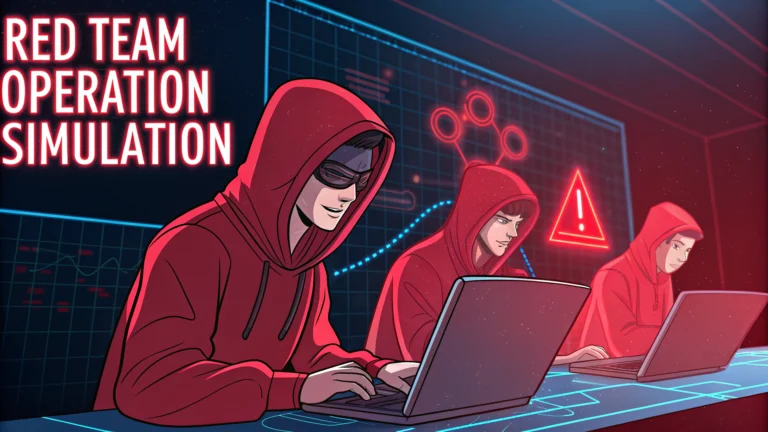Red team operations simulate real-world cyber attacks to identify security vulnerabilities in an organization’s systems, networks, and processes.
These authorized simulations help organizations strengthen their security posture by testing defensive capabilities against sophisticated attack scenarios.
Understanding red team operations is essential for security professionals who want to build robust defense strategies and protect against modern cyber threats.
Key Components of Red Team Operations
- Reconnaissance and Intelligence Gathering
- Social Engineering Attacks
- Physical Security Testing
- Network Penetration Testing
- Application Security Assessment
Planning Phase
A successful red team operation begins with defining clear objectives and scope with stakeholders.
Rules of engagement must be established to prevent disruption to business operations.
The red team develops attack scenarios based on real threat actor techniques.
Execution Techniques
| Technique | Description |
|---|---|
| OSINT | Gathering publicly available information about target systems |
| Phishing | Email-based social engineering attacks |
| Physical Intrusion | Testing physical security controls and access points |
| Exploitation | Leveraging vulnerabilities to gain system access |
Documentation and Reporting
Red teams must maintain detailed logs of all activities and findings.
- Document successful attack paths
- Record defensive controls encountered
- Note system vulnerabilities
- Track time spent on each phase
Tools and Resources
Professional red teams use a combination of commercial and open-source tools:
- Cobalt Strike – Advanced adversary simulation platform
- Metasploit – Exploitation framework
- Nmap – Network scanning
- Burp Suite – Web application testing
Legal Considerations
Written authorization must be obtained before conducting any red team activities.
Operations must comply with relevant laws and regulations like GDPR and HIPAA.
Non-disclosure agreements protect sensitive information discovered during testing.
Building Better Security
Findings from red team operations should directly influence security improvements.
Organizations should address identified vulnerabilities based on risk level and potential impact.
Regular red team exercises help maintain a strong security posture against evolving threats.
Contact professional red team service providers through organizations like RedTeam Security or Coalfire.
Post-Assessment Activities
After completing red team operations, organizations must focus on remediation efforts and lessons learned.
- Review findings with stakeholders
- Prioritize security improvements
- Update security policies and procedures
- Conduct follow-up testing
Training and Skill Development
Red team operators must continuously enhance their capabilities:
- Advanced penetration testing certifications
- Threat intelligence analysis
- New exploitation techniques
- Latest security tools and frameworks
Recommended Certifications
| Certification | Focus Area |
|---|---|
| OSCP | Offensive Security |
| CRTO | Red Team Operations |
| SANS GPEN | Network Penetration Testing |
Measuring Success
Effective metrics help evaluate red team operation outcomes:
- Time to detection
- Number of successful compromises
- Defense evasion rate
- Impact on business operations
Strengthening Cyber Resilience
Regular red team assessments are crucial for maintaining robust security defenses in today’s threat landscape.
Organizations must view red teaming as an ongoing process rather than a one-time exercise.
Integrating findings with blue team operations creates a more comprehensive security program.
Successful red team operations ultimately lead to improved incident response capabilities and stronger overall security posture.
FAQs
- What is a Red Team Operation Simulation?
A Red Team Operation is an authorized, adversary-based assessment that tests an organization’s security controls, detection capabilities, and incident response procedures by emulating real-world attack scenarios and techniques. - How does Red Team testing differ from standard penetration testing?
Red Team operations are typically more comprehensive, covert, and goal-oriented compared to standard penetration testing. They focus on multiple attack vectors simultaneously, often last longer, and aim to remain undetected while achieving specific objectives. - What are the main objectives of Red Team Operations?
The primary objectives include testing blue team capabilities, identifying security gaps, validating detection systems, assessing incident response procedures, and evaluating an organization’s overall security posture under realistic attack conditions. - What methodologies do Red Teams typically follow?
Red Teams commonly utilize frameworks like MITRE ATT&CK, kill chains, and APT simulation playbooks. They employ reconnaissance, initial access, privilege escalation, lateral movement, and actions on objectives as key phases. - What tools are commonly used in Red Team Operations?
Common tools include Cobalt Strike, PowerShell Empire, Metasploit, custom malware, social engineering frameworks, and various open-source intelligence (OSINT) tools for reconnaissance. - How long does a typical Red Team Operation take?
Red Team Operations usually span from several weeks to months, depending on the scope, objectives, and organization size. Some campaigns may run continuously as part of persistent security testing. - What qualifications should Red Team members possess?
Red Team members typically need advanced penetration testing skills, knowledge of multiple attack frameworks, programming abilities, social engineering expertise, and relevant certifications like OSCP, CRTP, or CREST. - How should findings from Red Team Operations be reported?
Reports should include executive summaries, detailed technical findings, attack paths, successful techniques, security control gaps, detection failures, and specific recommendations for improving security posture. - What legal considerations must be addressed before conducting Red Team Operations?
Organizations must establish proper scope documentation, legal authorization, rules of engagement, data handling procedures, and emergency protocols. Non-disclosure agreements and proper authorizations are essential. - How do Red Teams maintain stealth during operations?
Red Teams use techniques like traffic encryption, legitimate tool masquerading, timestamp manipulation, log cleaning, and mimicking normal user behavior to avoid detection while conducting operations.







